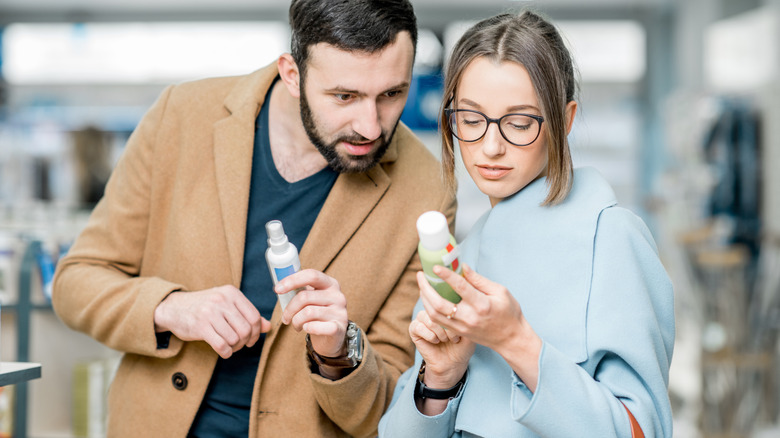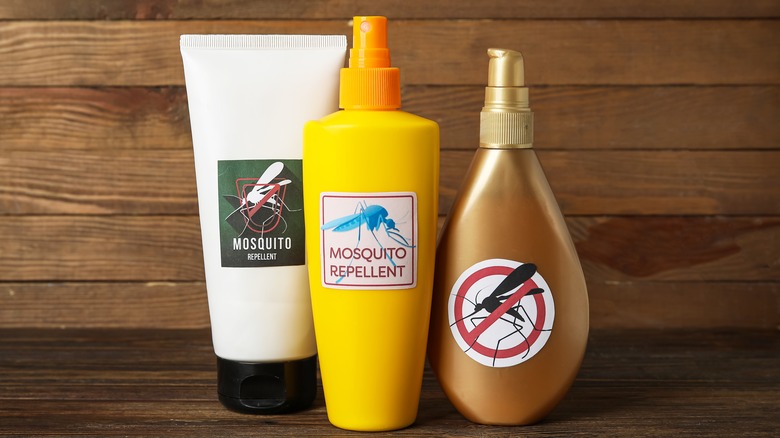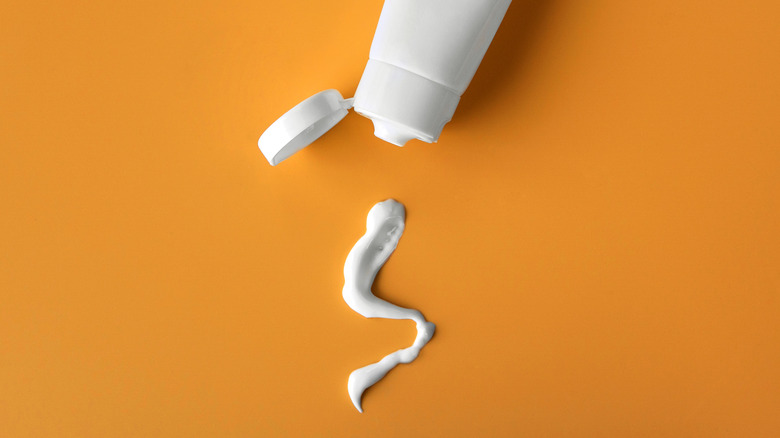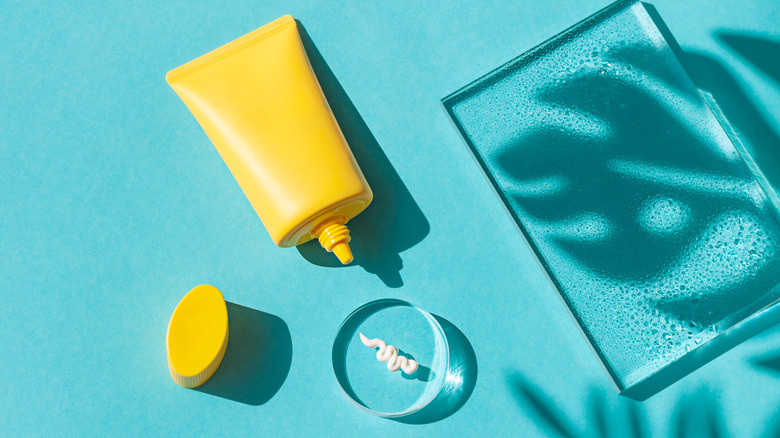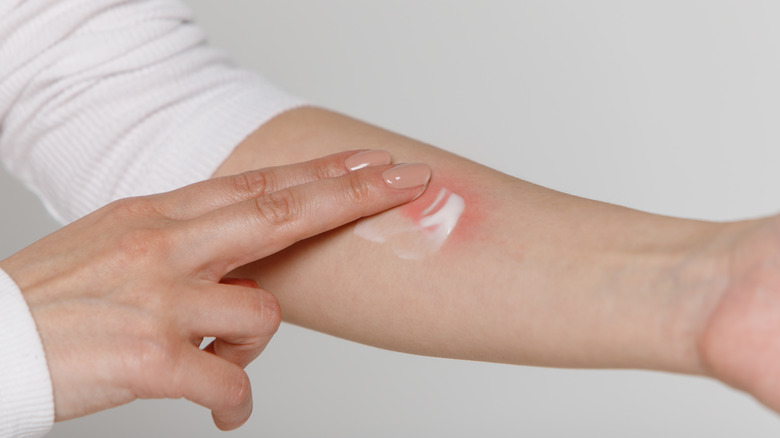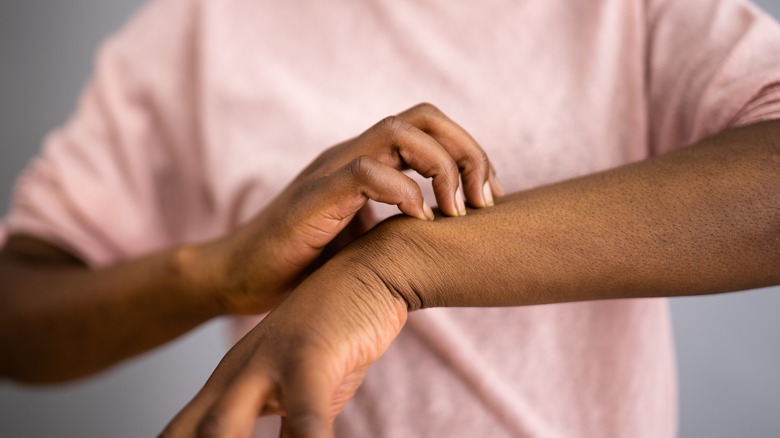If You See These Ingredients In Your Sunscreen, Don't Use It
If you like to spend warm summer days lounging in the sun, tackle a fair share of outdoor activities, or happen to work outside, then you likely know how important it is to wear sunscreen. Not only will it help to prevent nasty and painful burns, but it can also reduce the risk of skin cancer. Unfortunately, there's one sunscreen-related mistake that could end up causing you serious issues: opting for a sunscreen that includes iffy ingredients.
While research is still being done to fully understand the potential effects of what you might find in various kinds of sunscreen, there has definitely been a concerned buzz around certain ingredients over the last few years. For instance, the U.S. Food & Drug Administration (FDA) released various reports and came to the conclusion that there wasn't enough information available to back up claims that certain ingredients were harmless. Because of this, some people might be worried about applying random products they find on store shelves.
However, Margaret H Hager, M.D., a family medicine specialist with Hackensack Meridian Health Medical Group Primary Care-Forked River, explained, "People shouldn't avoid wearing sunscreen out of concern about certain ingredients; they should consider what ingredients are in their sunscreen and perhaps choose other products with different ingredients."
In order to ensure that you're choosing the best sunscreen for your skin, you may want to inform yourself about potentially problematic ingredients so that you can avoid products that use them.
Insect repellent
While spending time outside, you may want to protect yourself from both the harmful sun and annoying bugs. That's why a product that combines sunblock and insect repellent may appear to be a potential time-saver not to mention a skin-saver. However, it turns out that insect repellent is an ingredient you should avoid in your sunscreen.
Along with the fact that you should be applying sunscreen much more often than insect repellent, you also shouldn't be putting the latter on your face at all, according to the Kelowna Skin Cancer Clinic. While that is enough of a reason to buy and use these products separately, you should also know that the ingredients used in each can affect the other in negative ways. For instance, sunscreen can cause your skin to soak up more of what's found in the repellent, including N,N-diethyl-meta-toluamide (which you might know as DEET, per the United States Environmental Protection Agency). It can also increase the problems associated with DEET. On the other hand, repellents can make sunscreens less effective, which is obviously something that you don't want to happen.
Although there's no doubt that a sunscreen that boasts bug repellent may seem like a brilliant idea, in this case, the convenience just isn't worth it.
Octinoxate
Octinoxate is another ingredient found in sunscreen that you might also spot in the ingredient list on the label of your favorite makeup as well as a range of skincare products. A chemical that's also known as Octyl methoxycinnamate or OMC, the amount of octinoxate used in a product has been limited to certain levels by Canada, Japan, the European Union, and the United States, according to Healthline.
Even with these restrictions, octinoxate has been associated with reproductive issues as well as acne and other skin problems. Additionally, board-certified dermatologist Rachel Nazarian, M.D., F.A.A.D., of Schweiger Dermatology Group, told Byrdie that those with melasma may want to avoid sunscreen with octinoxate, saying, "...I would not recommend sunscreens with only octinoxate for this population. I would also recommend those with sensitive skin to consider a physical or mineral sunscreen rather than a chemical blocker such as octinoxate to minimize [the] risk of irritation."
While more research is being done on octinoxate, Nazarian points out that past studies have found the chemical may disrupt hormones when high amounts are consumed, however, notes that just .002% will be soaked up by the skin, which may keep it in a safe zone. This is another reason to either avoid sunscreens with octinoxate or choose one that stays uses a limited and therefore acceptable amount.
Oxybenzone
When scanning the ingredients in sunscreen, you'll also want to keep an eye out for oxybenzone. A compound that comes from benzophenone, it helps to protect you from UV radiation that comes from the sun. Jamie Alan, Ph.D., an assistant professor of pharmacology and toxicology at Michigan State University, told Prevention, "It's also found in plastics, toys, and some flowing plants."
Along with the fact that oxybenzone may disrupt hormone levels, which can lead to a number of concerning issues, Prevention points out that various tests have found that it can cause allergic reactions in the skin as well as pass into the blood, urine, breast milk, and amniotic fluid.
Oxybenzone can also be a threat to coral reefs, according to a study by Stanford University found in Science that found the ingredient can turn into a harmful phototoxin when soaked up by both coral and anemone in water. Because of this, Hawaii and Florida's Key West have created bans to prevent the use of sunscreens that include oxybenzone. Dr. Beth Goldstein, the co-founder of Modern Ritual and president of Central Dermatology in Chapel Hill, NC, explained to Medical News Today, "No sunscreens have been methodically studied with any standardization to determine if they are safe for the coral reef." However, Goldstein did suggest using a mineral-based sunscreen instead, saying, "These are proven to be effective for long bouts in the sun without fear of 'missing a spot' when diving for sometimes hours at a time."
Octisalate
"Octisalate is a chemical that's often found in sunscreen and works to prolong sun protection," Shuting Hu, a cosmetic scientist, formulator, and the founder of Acaderma, told Byrdie. Beyond that, it benefits your skin by helping to block UVB rays, which can lead to sunburns. Alan J. Parks, MD, a board-certified dermatologist and the founder of DermWarehouse, also noted, "Octisalate is also known to help stabilize other sunscreen ingredients as well as help make formulas more water-resistant."
An ingredient that the FDA says can only make up 5% of a product, according to The Derm Review, it has a long list of alternative names that you might find in your sunscreen, including EHS; 2-ethylhexyl ester benzoic acid, 2-hydroxy-; 2-ethylhexyl ester salicylic acid; 2-ethylhexyl salicylate; and ethylhexyl salicylate, 2-ethylhexyl. That's not to mention 2-hydroxybenzoate; 2-hydroxy- 2-ethylhexyl ester benzoic acid; benzoic acid, 2-hydroxy-, 2-ethylhexyl ester; benzoic acid, 2hydroxy, 2ethylhexyl ester; brn 2730664; and einecs 204-263-4. Did you get all of that? As for why you might want to avoid it, The Derm Review notes that it can hold on to sweat and keep it against your skin, which can cause breakouts.
Avobenzone
While other ingredients that are commonly found in sunscreen can keep potentially harmful UV rays from hitting your skin and harming it in seriously scary ways, avobenzone works a little differently. Dendy Engelman, M.D., a board-certified dermatologist, told PopSugar, "Avobenzone changes [the UV rays] into heat, and then releases the heat. Instead of sitting on top of the skin and deflecting the sun's rays, avobenzone converts UV rays into energy that is less damaging to the skin."
While that sounds ideal, avobenzone is a chemical that may also cause both photocontact dermatitis and allergic contact dermatitis, according to DermNet. On top of that, avobenzone is not a stable chemical. In fact, its effectiveness can drop dramatically — anywhere from 50% to a whopping 90% — in just an hour, which is why it's often paired with other chemicals that can support it. These additions may be the true cause of the annoying allergic reactions.
If that wasn't enough to make you wary of using avobenzone, anyone who is worried about the environment will, once again, be concerned about how this specific sunscreen ingredient might negatively affect the underwater world. Engelman explained to PopSugar, "[Avobenzone is] also often formulated with other chemical sunscreens that are known to cause or be linked to coral reef bleaching."
Aminobenzoic acid, para-aminobenzoic acid (PABA)
Known as aminobenzoic acid, para-aminobenzoic acid, or PABA, this chemical is found in sunscreen due to its ability to absorb UVB rays. Unfortunately, it's another ingredient that has been connected to both photocontact dermatitis and allergic contact dermatitis, according to DermNet. It can also spark irritating effects for people with sensitive skin, such as stinging and burning sensations. Beyond that, PABA may increase the chances of getting a sunburn instead of preventing one, which obviously isn't what you want to experience, per WebMD. If you take certain medications, you may want to ask your doctor if you need to avoid products with PABA. That includes sulfonamide antibiotics, dapsone (avlosulfon), and cortisone.
Finally, when it came to studies performed on animals — which don't always correlate to the effects on humans but can be a pretty good indicator — DermNet points out that scientists found that PABA may increase the risk of cellular UV damage. Yikes!
Although the FDA now limits products in the United States from using more than 15% of PABA in their formulas, it's on the list of prohibited ingredients in Canada. That's surely understandable when you realize that it might be causing more harm than good when it comes to your skin and overall health.
